The concept of the armoured cruiser had many origins and claiming nations. In the case of Russia, it is argued that the General Admiral class (1875) is a serious contenter. In fact exactly the same year, the British Royal Navy claimed their own: HMS Shannon. Started in 1873 at Pembroke Dockyard, she was repeat of the ironclad concept but on a nimbler hull (faster) with a bit less armour but longer range and defined to act independently against trade (and against defending cruisers).
The concept went back to the armoured frigates built already a decade earlier. But Shannon ported it to a new level. She is referred in the literrature of the time also as a “cruiser”, not a frigate. After a long but relatively uneventful career, Shannon was considered however a failure, converted as tender in 1883 already and scrapped in 1899.
Design
Development
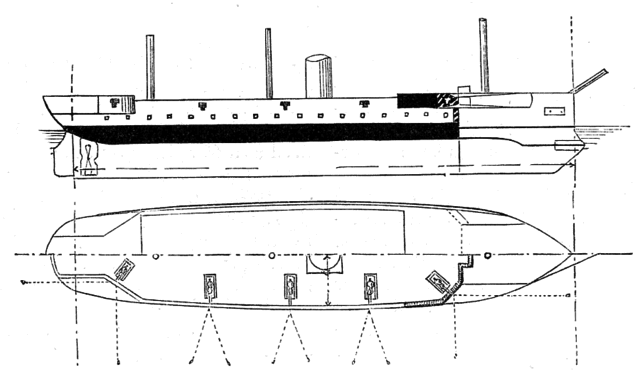
Brassey’s naval annual depiction of the ship, showing her armament and armour in 1875.
USS Shannon did not appeared in a vacuum, she was built in response to the new perceived threat of second class Ironclads (French in particular) at first, when the design was planned under instruction to Nathaniel Barnaby. This was aimed at the French Alma and La Galissonnière classes, but otjer comparable ships in Asia of the the Americas. However eventually the Audacious and Swiftsure classes were to adress this, and requirements changed as it was learned about the construction of the first Russian armoured cruisers, the General-Admiral and her sister Gerzog Edinburgski.
The latter were specially tailored to wage war on British commerce, and before the Russo-British naval arms race and 1890s “russian scare” in the Pacific, started with Rurik, there was already the need for a countering ship. The General Admiral were armed like second-class ironclads, and plans for Shannon were revised to not only counter them but perform commerce protection missions until then given to unarmoured cruisers such as the Inconstant class.
Hull and general design
Shannon was not that “elongated” as a cruiser, with a beam ratio of only 1/5 due to her hull Length (at the ram end) of 260 ft (79 m) for a beam of 54 ft (16.5 m) and her draught of 22 ft 3 in (6.78 m), over a standard displacement of 5,670 tons. She has a single funnel, forward conning tower, and two bridges fore and aft, with a main forward navigation bridge and steering backup post aft. She had three squared masts, three stages, bowsprit and stud. Her straight bow hid her ram, and she ended with a rounded poop, completed with admiral walkway and decorative officer’s galley typical of the time. For overseas operations in tropical climate, and reduce fouling, she had zinc and wood sheathing on her hull.
Armour protection layout
HMS Shannon was armoured in an unconventional manner, mixed, using metal backup by wood.
-Her armoured belt was 9 feet (2.7 m) tall, 6 to 6 inches (150 to 230 mm) in thickness depending on the area, running for for most of her length, but 60 feet (18 m) short from her bow.
-The main belt made in 6-9 in of special treatment iron was backed by 10 to 13 in (250 to 330 mm) teak.
-Her armoured deck was 1.5 inches (38 mm) in thickness, and was a first in any British warship.
-A 9-in armoured bulkhead ran across the ship where the belt ended. It’s top was cut by embrasures for the upper deck 10-inch guns.
-At its bottom was a 3-inch (76 mm) thick armoured deck up to the bow, 10 feet (3.0 m) below the waterline. So these bulkheads range from 200 to 230 mm.
Above the forward armoured deck coal bunkers and stores compartimented the space to contain flooding.
-Her Conning tower forward was 9 in (230 mm) thick.
-The 9-inch guns were unarmoured:
Crew protection was an issue in a conventional fight, which was out of question. The main tactic was planned to ram the enemy while firing with the forward guns, preparing the 9-inch broadside, and the crew would retreat into armoured part. If the ramming failed the broadside guns were to fire electrically when passing along. So she also invented remote weaponry in 1875.
Powerplant and rigging
As a mixed ship, HMS Shannon was given both a steam engine and a generous rigging. The inefficience of steam power at the time meant to spare coal, she was to go with sails when possible.
Steam was preferred for combat and sail for distant station operations. To better perform in this manner, she was given a lifting screw to clean her hull lines. But this was the last time any Royal Navy warship was equipped in such a way.
Her steam engine propelled a single large four-bladed bronze propeller. The drive shaft was powered by a single Laird two-cylinder horizontal compound engine. Its high-pressure cylinders measured 44 inches (110 cm) in diameter, the low-pressure ones 85 inches (220 cm). Eight cylindrical boilers working at 70 lb (32 kg) pressure fed the steam. Design top speed was set to 13 knots (24 km/h; 15 mph), but in trials, even lightened, she could not pass 12.25 knots (22.69 km/h; 14.10 mph).
As for rigging, her initial rig totalled 24,000 square feet (2,200 m2) of sail, as insisted upon by the Director of Naval Operations of the time, Captain Hood. In service it was reduced to barque rig (last mast stage removed) with 21,500 sq ft (2,000 m2).
Armament
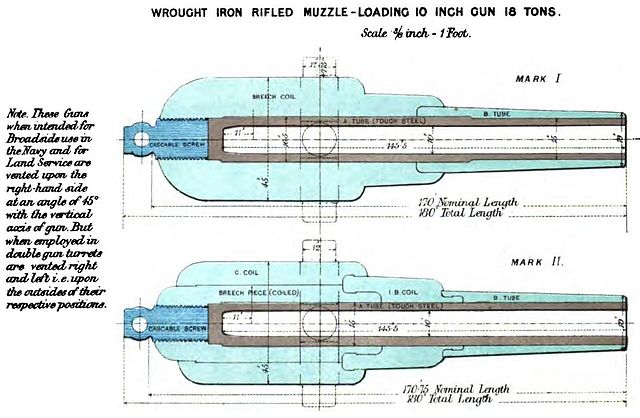
HMS Shannon’s main armament comprised two 10-inch guns, placed in armoured embrasures facing towards the bow. These were recent RML 10-inch guns Mk II, large rifled muzzle-loading guns designed for battleships and monitors, entering service in 1868. They fired 400 to 410 pounds (181.4 to 186.0 kg) Palliser, Common, Shrapnel shell at 1,364 to 1,028 fps, up to 6,000 yards (5,500 m)
This was completed by six 9-inch guns on the open deck amidships, plus a seventh facing astern, which could be traverse from either of two unarmoured embrasures aft.
These RML 9-inch guns Mark II were large rifled muzzle-loading guns entering service in 1865. At 12 tons for 125 inches (3.2 m) barrel they fired a 250 to 256 pounds Palliser, Common, Shrapnel at 1,420 fps (430 m/s) up to 9,919 yards (9,070 m), so they fires 1/3 further than the main guns !
Her most unusual feature perhaps was her detachable ram, removed in peacetime to reduce collision damage. It was was supposed to be stowed on board, attached in wartime but this proved ludicrous and it stayed attached in practice, just like her propeller.
In 1881, HMS Shannon was partially rearmed: She received six 20-pounder (9 kg) breech-loading guns and four torpedo tubes (likely the 15in or 381 mm first generation) but kept her 10-in guns.
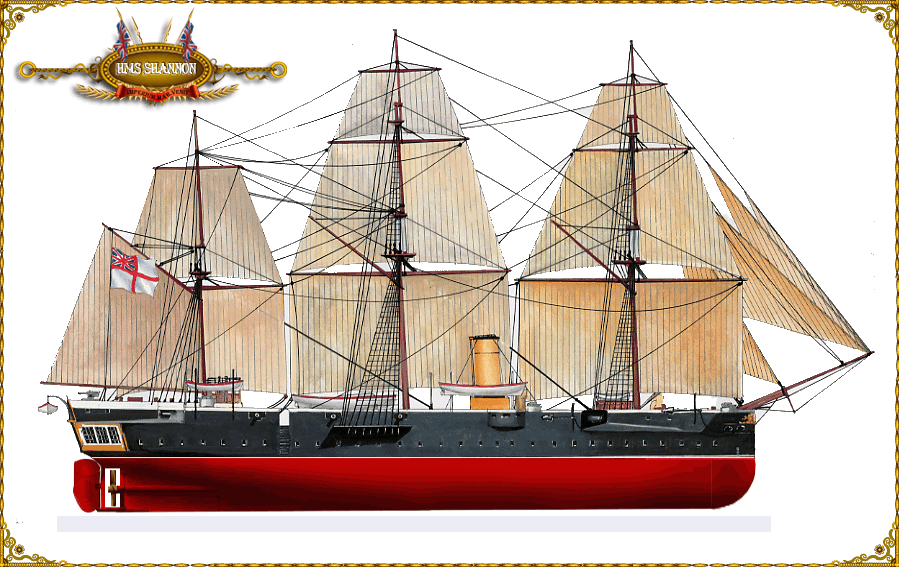
Author’s rendition of HMS Shannon
⚙ specifications |
|
| Displacement | 5,670 tons |
| Dimensions | 260 x 54 x 22 ft 3 in ft (79 x 16.5 x 6.78 m) |
| Propulsion | 1 screw Laird CH steam engine, 8 cyl. boilers 3,370 ihp (2,510 kW) |
| Rig | 24,000 sq ft (2,200 m2), later 21,500 sq ft |
| Speed | 12.25 knots (22.69 km/h; 14.10 mph) max |
| Range | 280 tons coal, later 560 tons |
| Armament | 2× 10-in MLRs, 7× 9-in MLRs, see notes |
| Protection | Belt 6-9 in backed, Deck 1.5-3 in, Bulkheads 8-9 in CT 9 in |
| Crew | 452 |
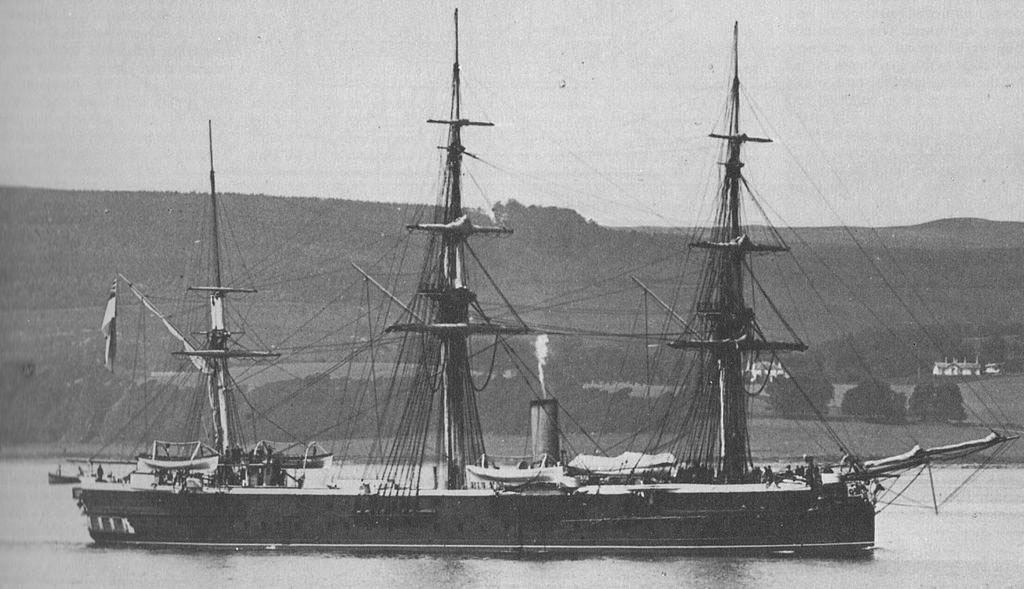
As completed in 1875
HMS Shannon’s construction was ordered to Pembroke Dockyard, she was laid down on 29 August 1873, Launched on 11 November 1875 and Commissioned 17 September 1877. Construction cost was £233,902 for her hull, £53,367 for her machinery, £287,269 total exclusing the armament. Soon after disappointing sea trials it appeared that she was something of a failure as a warship: Although she was lighter and yet better armed than the Swiftsure and Audacious she equalled foreing “station ironclad” but was far too slow as a cruiser. Paet of it was due to the immense drag caused by her sail which was efficient for long range missions, but incompatible with cruiser-catching duties. She was no more than a “station ironclad” herself, and posted as such during her career.
But HMS Shannon was only posted on overseas stations for a short time. After commission, the commission estimated she was also over-weight while her engines torublesome, which sent her stright to drydocjk for prolongated persios, so muich so she spent most of her time until March 1878 in modifications. Her shakedown cruise with the Channel Fleet was delayed until then and by April 1878 her departure for the China Station was recalled in July. She entered the drydock for more changes instead and was recommissioned by December 1878, and stuck in the Channel fleet, alternated with short stays with the Mediterranean fleet at Gibraltar.
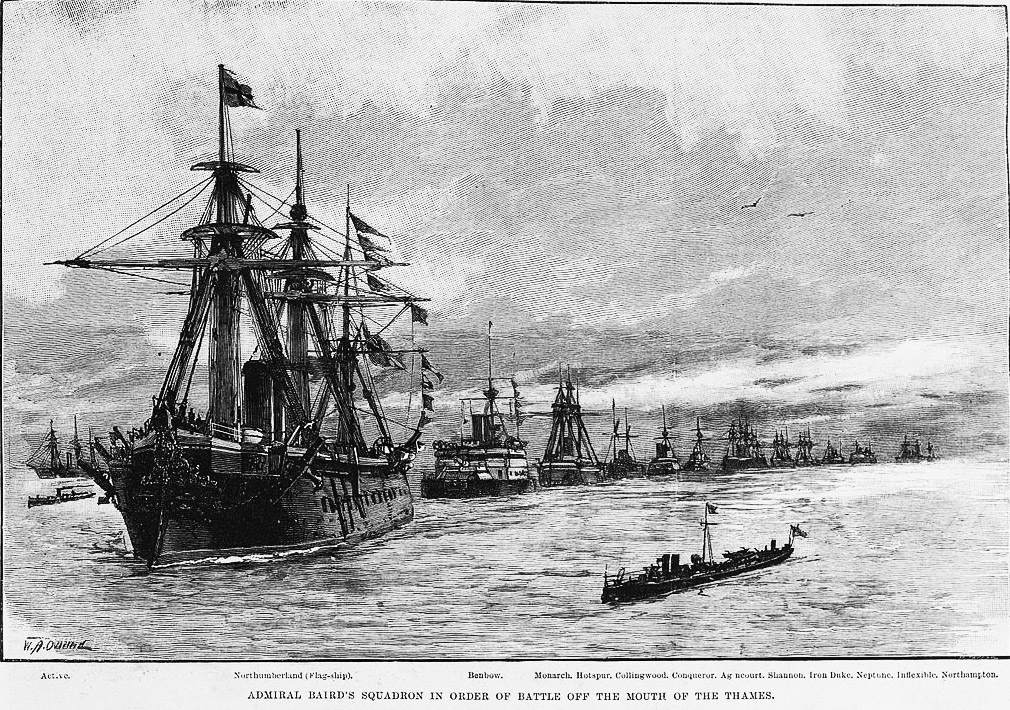
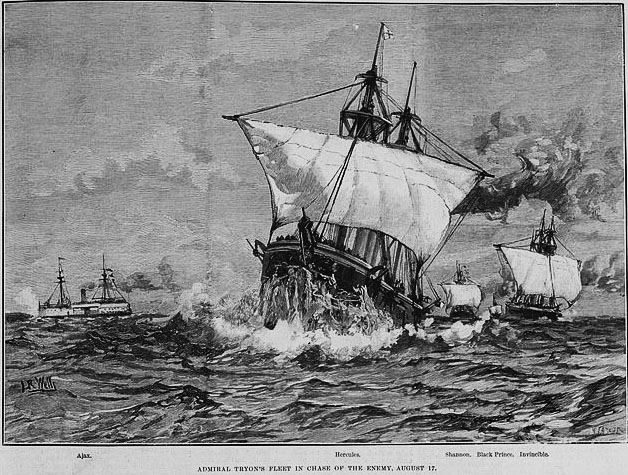
At last she was despatched to the Pacific in July 1879 as the only British warship with 10-in guns, but she was prohibited to gunnery practice due to the cost of moving shells in her station. She was back home by July 1881, then refitted again to have her main guns changed to standards compatible with this station, but the planning replacement of her 10-inch guns in 1881 refit was cancelled and instead she was barred to overseas service. She stayed at the Channel station seeing little activity in 1882.
In May 1883 she became a tender to HMS Warrior. In 1884, she became a coastguard ship. During the Panjdeh Incident (1885) she was fully reactivated but did not sailed anywhere. She served in reduced commissioned for the next decaede. By May 1895 she was placed in reserve. In 1898 she was stricken and sold for breaking up in December 1899, at a price of £10,105.
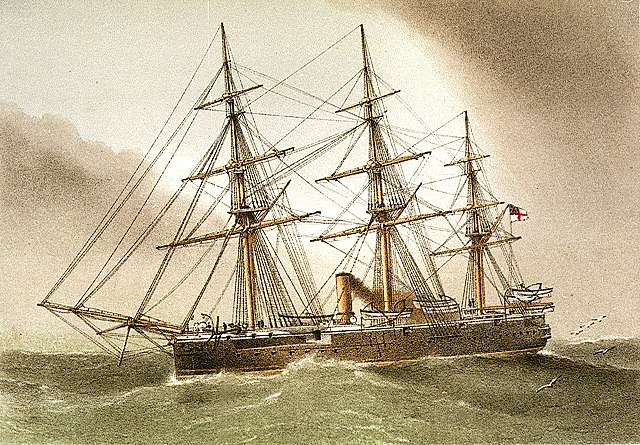
Read More
Books
John Beeler, Birth of the Battleship – British capital ship design 1870–1881, Chatham Publishing, 2001
Brassey, T.A. (ed) The Naval Annual 1895
Chesneau, Roger & Kolesnik, Eugene M., eds. (1979). Conway’s All the World’s Fighting Ships 1860–1905.
Colledge, J. J.; Warlow, Ben (2006) [1969]. Ships of the Royal Navy, Complete Record, Chatham Publishing.
Friedman, Norman (2012). British Cruisers of the Victorian Era. Barnsley, South Yorkshire, UK: Seaforth
David Lyon, The Ship – Steam, steel and torpedoes, National Maritime Museum, 1980
Parkes, Oscar (1990). British Battleships (reprint of the 1957 ed.). NIP
Silverstone, Paul H. (1984). Directory of the World’s Capital Ships. Hippocrene Books.
Sondhaus, Lawrence Naval Warfare 1816–1914. Routledge, London, 2001.
Links
on pdavis.nl/
on dreadnoughtproject.org/
on wikipedia.org/
print on magnoliabox.com/
on worldnavalships.com/
on warshipsresearch.blogspot.com/
on naval-history.net
on wiki.lesta.ru/
Videos
Dr. Clarke about Shannon


 Latest Facebook Entry -
Latest Facebook Entry -  X(Tweeter) Naval Encyclopedia's deck archive
X(Tweeter) Naval Encyclopedia's deck archive Instagram (@navalencyc)
Instagram (@navalencyc)





 French Navy
French Navy Royal Navy
Royal Navy Russian Navy
Russian Navy Armada Espanola
Armada Espanola Austrian Navy
Austrian Navy K.u.K. Kriegsmarine
K.u.K. Kriegsmarine Dansk Marine
Dansk Marine Nautiko Hellenon
Nautiko Hellenon Koninklije Marine 1870
Koninklije Marine 1870 Marinha do Brasil
Marinha do Brasil Osmanlı Donanması
Osmanlı Donanması Marina Do Peru
Marina Do Peru Marinha do Portugal
Marinha do Portugal Regia Marina 1870
Regia Marina 1870 Nihhon Kaigun 1870
Nihhon Kaigun 1870 Preußische Marine 1870
Preußische Marine 1870 Russkiy Flot 1870
Russkiy Flot 1870 Svenska marinen
Svenska marinen Søværnet
Søværnet Union Navy
Union Navy Confederate Navy
Confederate Navy Armada de Argentina
Armada de Argentina Imperial Chinese Navy
Imperial Chinese Navy Marinha do Portugal
Marinha do Portugal Mexico
Mexico Kaiserliche Marine
Kaiserliche Marine 1898 US Navy
1898 US Navy Sovietskiy Flot
Sovietskiy Flot Royal Canadian Navy
Royal Canadian Navy Royal Australian Navy
Royal Australian Navy RNZN Fleet
RNZN Fleet Chinese Navy 1937
Chinese Navy 1937 Kriegsmarine
Kriegsmarine Chilean Navy
Chilean Navy Danish Navy
Danish Navy Finnish Navy
Finnish Navy Hellenic Navy
Hellenic Navy Polish Navy
Polish Navy Romanian Navy
Romanian Navy Turkish Navy
Turkish Navy Royal Yugoslav Navy
Royal Yugoslav Navy Royal Thai Navy
Royal Thai Navy Minor Navies
Minor Navies Albania
Albania Austria
Austria Belgium
Belgium Columbia
Columbia Costa Rica
Costa Rica Cuba
Cuba Czechoslovakia
Czechoslovakia Dominican Republic
Dominican Republic Haiti
Haiti Hungary
Hungary Honduras
Honduras Estonia
Estonia Iceland
Iceland Eire
Eire Equador
Equador Iran
Iran Iraq
Iraq Latvia
Latvia Liberia
Liberia Lithuania
Lithuania Mandchukuo
Mandchukuo Morocco
Morocco Nicaragua
Nicaragua Persia
Persia San Salvador
San Salvador Sarawak
Sarawak Uruguay
Uruguay Venezuela
Venezuela Zanzibar
Zanzibar Warsaw Pact Navies
Warsaw Pact Navies Bulgaria
Bulgaria Hungary
Hungary

 Bundesmarine
Bundesmarine Dutch Navy
Dutch Navy Hellenic Navy
Hellenic Navy Marina Militare
Marina Militare Yugoslav Navy
Yugoslav Navy Chinese Navy
Chinese Navy Indian Navy
Indian Navy Indonesian Navy
Indonesian Navy JMSDF
JMSDF North Korean Navy
North Korean Navy Pakistani Navy
Pakistani Navy Philippines Navy
Philippines Navy ROKN
ROKN Rep. of Singapore Navy
Rep. of Singapore Navy Taiwanese Navy
Taiwanese Navy IDF Navy
IDF Navy Saudi Navy
Saudi Navy Royal New Zealand Navy
Royal New Zealand Navy Egyptian Navy
Egyptian Navy South African Navy
South African Navy






























 Ukrainian Navy
Ukrainian Navy dbodesign
dbodesign